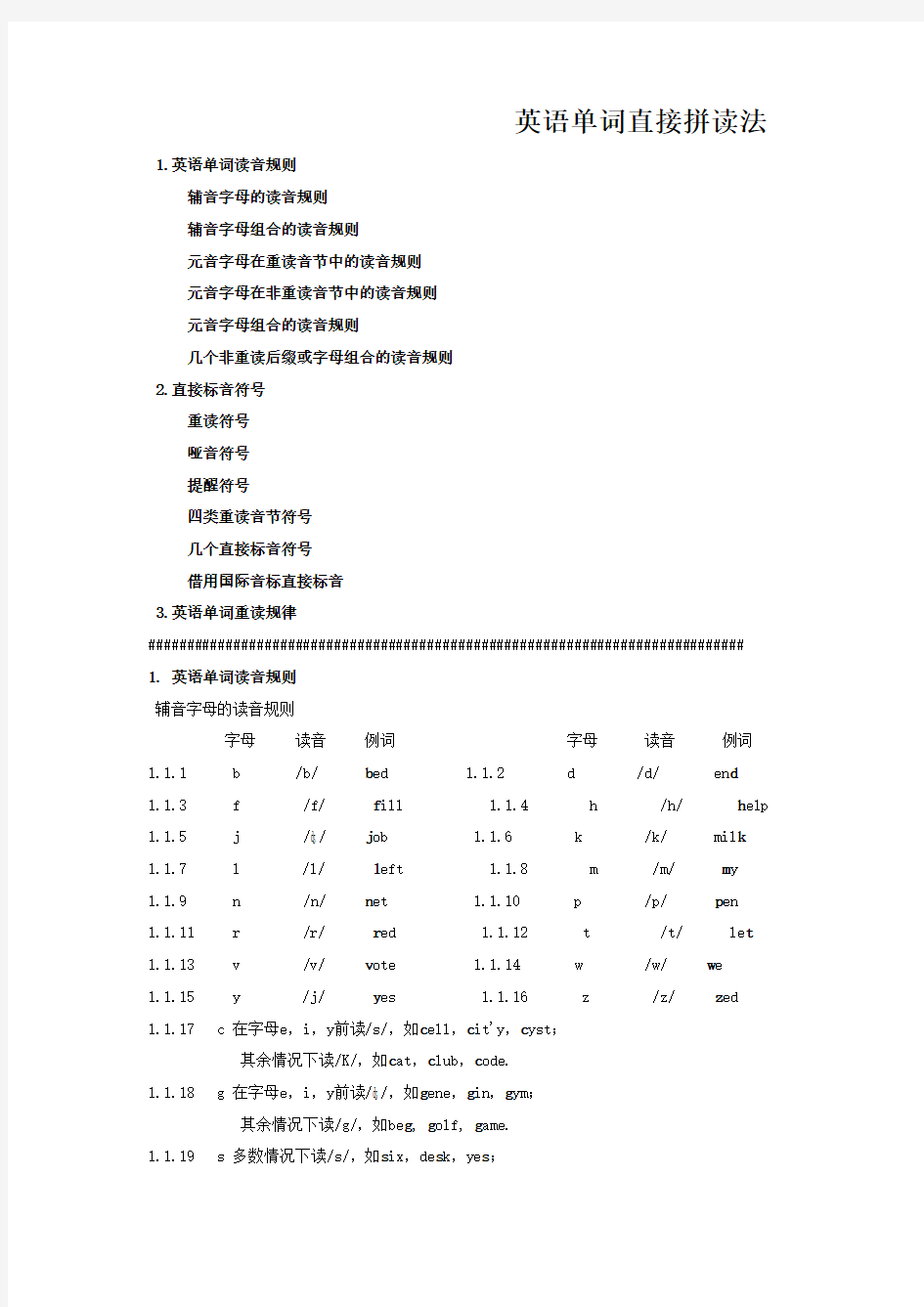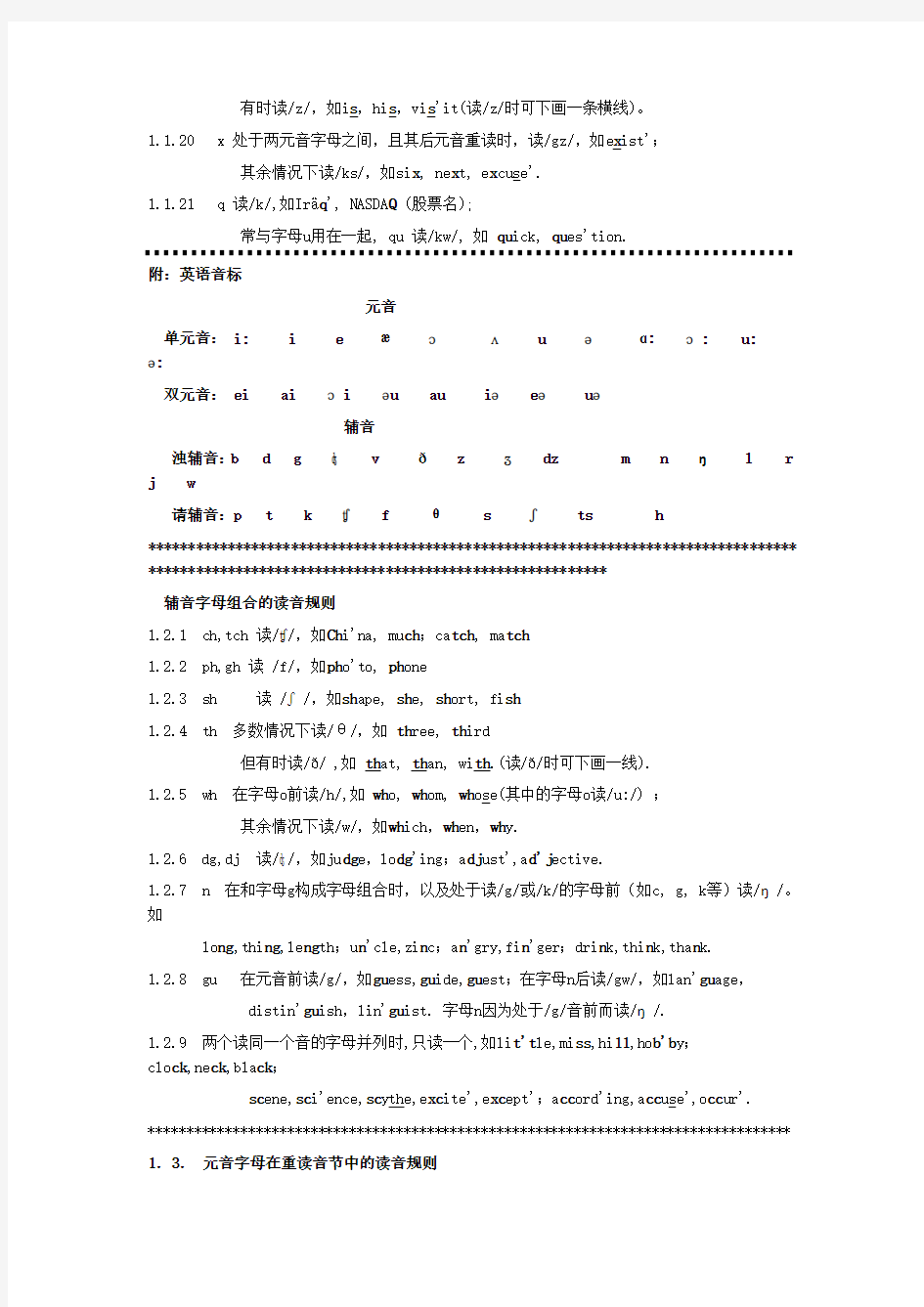

英语单词直接拼读法 1.英语单词读音规则
辅音字母的读音规则
辅音字母组合的读音规则
元音字母在重读音节中的读音规则
元音字母在非重读音节中的读音规则
元音字母组合的读音规则
几个非重读后缀或字母组合的读音规则
2.直接标音符号
重读符号
哑音符号
提醒符号
四类重读音节符号
几个直接标音符号
借用国际音标直接标音
3.英语单词重读规律
############################################################################# 1. 英语单词读音规则
辅音字母的读音规则
字母读音例词字母读音例词1.1.1 b /b/ b ed 1.1.2 d /d/ en d
1.1.3 f /f/ f ill 1.1.4 h /h/ h elp 1.1.5 j /?/ j ob 1.1.6 k /k/ mil k 1.1.7 l /l/ l eft 1.1.8 m /m/ m y
1.1.9 n /n/ n et 1.1.10 p /p/ p en
1.1.11 r /r/ r ed 1.1.12 t /t/ le t 1.1.13 v /v/ v ote 1.1.14 w /w/ w e
1.1.15 y /j/ y es 1.1.16 z /z/ z ed
1.1.17 c 在字母e,i,y前读/s/,如c ell,c it'y,c yst;
其余情况下读/K/,如c at,c lub,c ode.
1.1.18 g 在字母e,i,y前读/?/,如g ene,g in,g ym;
其余情况下读/g/,如be g, g olf, g ame.
1.1.19 s 多数情况下读/s/,如s ix,de s k,ye s;
有时读/z/,如i s,hi s,vi s'it(读/z/时可下画一条横线)。
1.1.20 x 处于两元音字母之间,且其后元音重读时,读/gz/,如e x ist';
其余情况下读/ks/,如si x, ne x t, e x cuse'.
1.1.21 q 读/k/,如Ir?q', NASDA Q (股票名);
常与字母u用在一起, qu 读/kw/, 如qu ick, qu es'tion.
附:英语音标
元音
单元音: i: i e ??? u ?ɑ: ?: u:
?:
双元音: ei ai ?i ?u au i? e? u?
辅音
浊辅音:b d g ? v e z ? dz m n ? l r
j w
请辅音:p t k ? f θ s ?ts h
**********************************************************************************
**********************************************************
辅音字母组合的读音规则
1.2.1 ch,tch 读/?/,如Ch i'na, mu ch;ca tch, ma tch
1.2.2 ph,gh 读 /f/,如ph o'to, ph one
1.2.3 sh 读 /?/,如sh ape, sh e, sh ort, fi sh
1.2.4 th 多数情况下读/θ/,如th ree, th ird
但有时读/e/ ,如th at, th an, wi th.(读/e/时可下画一线).
1.2.5 wh 在字母o前读/h/,如wh o, wh om, wh ose(其中的字母o读/u:/) ;
其余情况下读/w/,如wh ich,wh en,wh y.
1.2.6 dg,dj 读/?/,如ju dg e,lo dg'ing;a dj ust',a d'j ective.
1.2.7 n 在和字母g构成字母组合时,以及处于读/g/或/k/的字母前(如c, g, k等)读/?/。
如
lo ng,thi ng,le ng th;u n'cle,zi n c;a n'gry,fi n'ger;dri n k,thi n k,tha n k.
1.2.8 gu 在元音前读/g/,如gu ess,gu ide,gu est;在字母n后读/gw/,如lan'gu age,
distin'gu ish,lin'gu ist. 字母n因为处于/g/音前而读/?/.
1.2.9 两个读同一个音的字母并列时,只读一个,如li t't le,mi ss,hi ll,ho b'b y;
clo ck,ne ck,bla ck;
sc ene,sc i'ence,sc ythe,e xc ite',e xc ept';a cc ord'ing,a cc use',o cc ur'.
*********************************************************************************** 1.3.元音字母在重读音节中的读音规则
英语中有四类重读音节:闭音节,开音节,r音节,re音节。
1.3.1 闭音节指以辅音字母结尾的音节。
元音字母a,e,i(y),o,u在重读闭音节中分别读/?1.3.2 开音节指以元音字母、‘元音字母+哑e’或‘一个辅音字母+哑e’结尾的音节。
后者也叫约定开音节.
元音字母a,e,i(y),o,u在重读开音节中分别读/ei但字母u 在字母j,l,r后,读/u:/,不读/ju:/,如 J u ne,bl u e,r u le.
1.3.3 r音节指以字母r或‘r +辅音字母’结尾的音节。
在r音节中:ar读/ɑ:/, or读/?:/,er, ir, yr, ur 都读/?:/。
如:ar m,f ar,st ar t,l ar ge,M ar x;or,f or,c or d,or'der;
v er b,h er,s er ve;s ir,f ir st,d ir t'y,c ir'cle,m yr'tle;
h ur t,n ur se,ret ur n',m ur'mur.
注1.双r前的音节,是闭音节,不是r音节。如:
c a r'ry,m a r'ry,b e r'ry,m i r'ror,s o r'ry,h u r'ry.
注2.在/w/音后,ar读/?:/, 如 w ar,w ar m,w ar n;or读/?:/, 如
w or d,w or k,w or ld,w or se.
1.3.4 re音节指元音字母与 re 结合而成的音节。
在re音节中:are读/e?/,ere读/i?/,ire,yre读/ai?/,ore读/ ?:/, ure读/ ju?/。如:
c are,
d are,r are,h are,prep are';h ere,m ere,sev ere';f ire,w ire,t ire,ent ire',t yre;
m ore,f ore,c ore,bef ore'; c ure,p ure,end ure'
**********************************************************************************元音字母在非重读音节中的读音规则
1.4.1 a,o,u读/?/,如 Chi'n a, sec'o nd, dif'fic u lt.
1.4.2 e, i, y读/i/,如 r e sult',vic't i m,hap'p y.
1.4.3 ar,er,ir,or,ur,yr 读/?/,如 gram'm ar,let't er,c ir cum'f er ence,doc't or,
mur'm ur,mar't yr,p er sist',west'er n,east'er n.
1.4.4 o,u 处于词末时分别读/?u/,/ju:/(即不弱化,按重读音节规则读)。
如 car'g o, Ne'gr o;men'u.
1.4.5 u在多音节词中,紧邻重读音节时,读/ju/(即轻度弱化)。如
reg'u lar,pop'u lar,mon'u ment.
1.4.6 a,i,y,u 在多音节动词中,处于约定开音节结尾中,按重读音节读。如
i'sol a te,ad'vert i se,an'al y se,sub'stit u te.
1.4.7 y在多音节动词词末不弱化,读/ai/。如:sat'isf y,mal'tipl y,oc'cup y
*********************************************************************************
元音字母组合的读音规则
1.5.1 au,aw读/?:/,如 c au se, au'ral, l au nch, s au ce, l aw, d aw n.
1.5.2 eu,ew(iew)读/ju:/,如 n eu'tral, d eu ce;n ew, v iew, rev iew'.
1.5.3 ou,ow 读/au/,如 h ou se, l ou d;h ow,n ow, d ow n.
1.5.4 ai,ay 读/ei/,如 w ai t, ai d;d ay, m ay.
1.5.5 ei,ey 读/ei/,如 v ei l, w ei g?h?t;gr ey, th ey, conv ey'
1.5.6 oi,oy 读/?i/,如 ch oi ce, oil;b oy, t oy.
1.5.7 ea,ee读/ i:/,如ea t, ch ea p;d ee p, n ee d.
1.5.8 ie,(c)ei读/i:/,如 f ie ld, bel ie ve';rec ei ve', c ei l'ing.
1.5.9 oa读/?u/,如 r oa d, s oa p, b oa t.
1.5.10 ue读/ju:/,如 T ue s’day, val'ue, purs ue'.
1.5.11 air,aer读/e?/,如air,f air; aer'ial, aer'oplane?.
1.5.12 ear,eer读/i?/如 ear, cl ear;b eer, d eer.
1.5.13 our读/au?/如our, s our, h?our.
1.5.14 oo 1.读/u/: 在字母k前(b oo k,l oo k,t oo k)和在g oo d,f oo t,st oo d,w oo d,w oo l
及其派生词(g oo d'ness,f oo t'ball,w oo l'en等)中读/u/。
2.读/u:/: 在其余情况下读/u:/,如: c oo l,f oo d,l oo se,r oo m,z oo.
3.读/? /: 在flood,blood及其派生词(flood'ing,blood'less等)中读/? /.
1.5.15 igh读/ai/,如 h igh, li ght, m igh t, n igh t.
1.5.16 augh,ough读/?:/,如 d augh'ter, c augh t, t augh t;ought,f ough t, th ough t。
1.5.17 oul 在could,should,would 中读/u/。
***********************************************************************************几个非重读后缀或字母组合的读音规则
1.6.1 a在后缀-ace,-ade,-age,-ate中读/i/,如 pal'a ce,com'r a de,vil'l a ge,ac'cur a te.
1.6.2 e在后缀-el,-en,-ent,-ence,-ency中读/?/,如
cru'e l,o’p e n,stu'd e nt,si'l e nce,flu'e ncy.
1.6.3 i在后缀-ible中读/?/, 如 pos's i ble.
1.6.4 ai,ay,ei,ey在非重读音节中一般弱读为/i/,如
moun't a i?n,Fri'd a y?,for'f ei t,val'l e y?.
1.6.5 -ful读/ful/,如 help'ful, harm'ful, use'fu l.
1.6.6 -gue读/g/,如 di'alo gue, cat'alo gue.
1.6.7 -que 读/k/,如 che que, pic'tures que'.
1.6.8 -ous读/?s/,如 fa'm ous, gen'er ous, nerv'ous.
1.6.9 -our读/?/,如 fa'v our, h?on'our, la'b our.
1.6.10 -ure读/?/,如 fig'ure, in'j ure. 但在fail'ure中读/j?/.
1.6.11 -ow读/?u/,如 win'd ow, yel'l ow, pil'l ow.
1.6.12 -ture读/??/,如 pic'ture, cul'ture, fur'ni ture.
1.6.13 -sure在元音字母后读/??/,如 clo'sure, expo'sure.
在辅音字母后读/??/,如 pres'sure,fle x'ure(x=ks).
1.6.14 -ion读/?n/, 如 fash'ion, c u?sh'ion.
1.6.15 -tion读/??n/如 na'tion, produc'tion, solu'tion.
1.6.16 -stion读/s??n/ , 如 que s'tion, suge s'tion, dige s'tion.
1.6.17 -sion在元音字母后读/??n/,如 v?'sion, occa'sion, div?'sion;
在辅音字母后读/??n/,如 discus'sion,impres'sion,expan'sion.
1.6.18 -ce,-ci,-si,-ti,-xi 在字母a,e,o前读/?/,如: o'ce an; so'ci al;A'si a;par'ti al;
Egyp'ti an;suff?'ci ent;pa'ti ent;pr?'ci ous;Rus'si an;an'xi ous.
1.6.19 -i在字母d,t,n,l后,且在元音字母前,读/j/。如
au'd i ence,fron't i er,opin'i on,famil'?ar.
1.6.20 -ed(过去式后缀)
在清辅音后读/t/,如:work ed, jump ed, miss ed.
在浊辅音和元音后读/d/,如:robb ed, begg ed;play ed,stud'i ed.
在字母d,t 后读/id/,如:need'ed, pl?nt'ed.
1.6.21 -(e)s(名词或动词词尾)
在清辅音后读/s/,如:desk s, lamp s, look s.
在浊辅音和元音后读/z/,如:pig s, pen s, play s, go es.
在/?,?,?,z,s/等音后读/iz/,如:urg'es, watch'es, wish'es, rīs'es, fac'es.
############################################################################
重读符号
2.1.1 单音节词单读时都重读,不需要用重读符号标注。双音节词和多音节词中,有的音节是重读音节,
有的则是非重读音节,重读音节就要用重读符号标注。有些单词中,除重读音节和非重读音节外,还有
次重读音节,也需要用重读符号标注。
2.1.2 在单词上直接标音时,重读符号(')标在重读音节的后上方(如 read'ing);次重音符号(?)
标在次重读音节的后下方(如 en?gineer')。请注意:直接标音法的重读符号,还具有分音节的作用,
如 stu'dent 和 stud'y, stu' 是开音节,而stud'是闭音节,故字母u的读法不同(见1.3.1和)。
*********************************************************************************** ****
哑音符号( . ) 可用来指出不读音的字母。标注了这个符号的字母,读音时可视若其无,其余的字母
仍按前述读音规则读音。详见2.2.1, 2.2.1 不读音的辅音字母。例如:?k nife, la m?b, au'tu m?n,?w rite,?p s y?chol'ogy,?p neumo'nia,
e x?h ib'it, r?h yme, whis'?t le, lis'?t e?n,?h our.
2.2.2 不读音的元音字母。例如:
h?e art, e?a rn, l e?a rn, e?a r'ly, y e?a r, d?o or, f l?o or, r o?a r, b o?a rd, c o?a rse, h o?a rse, f o?u r,
p o?u r, c o?u rse, t?o uch, c?o un'try, f r?i end, b?u ild, y?o ung, p e?o'ple, th o??u?g?h, o w?e?,?e y?e.?
2.2.3 因强度弱化而不读音的元音字母。例如:
vi't?a l, fi'n?a l, short'?e n, les's?e n, lev'?e l, chan'n?e l, dev'?i l, civ'?i l, es's?o n, cot't?o n,
cer't?a?i n, cur't?a?i n, poi's?o nous, dif'f?e rent, in't?e resting.
2.2.4 ‘哑e’一般可以不用哑音符号,但容易引起混淆时仍需使用。例如:
amuse' amu s?e'ment shame sha m?e d becide' beci d?e s
*********************************************************************************** ***
提醒符号( ?)用于:1.提醒发浊音,见2.3.1;
2.提醒发音不符合前述读音规则,见2.
3.2, ,;
3.提醒其读音标在单词后面,见2.3.5.
2.3.1 提醒s,th,x,f发浊音/z/,/ e/,/gz/,/v/。例如:
vi s'it, hi s, i s;th at, wi th, fur'th er, ga th'er;e x ist', e x am' ;o f.
2.3.2 提醒在非重读音节中a,o,u不读/?/,而读/i/。例如:
char'a cter, lit'er a ture, tem'per a ture; hy'dr o gen; min'u te.
2.3.3 提醒e,i,y不读/i/,而读/?/。例如:
can'c e l;A'pr i l,hol'i day;anal'y sis
2.3.4 提醒在e,i,y前g不读/?/,而读/ɡ/。例如:
g et,g ift,g ive,g irl,be g in',for g et',tar'g et.
2.3.5 提醒该字母(组合)的读音用国际音标标注在单词后边。例如:
ma ch?ne' /?/, ch ef /?/, g?r'a g e /?/, re g?me'/?/, for t une /?/, u's ual /?/,
proce'd ure /?/,sol'di er / ?/, suite /w/, pers u ade' /w/, diss u ade' /w/, cl er k /ɑ:/, s ew /?u/, s ew'ing /?u/, s u?g'er /?/, s u?re /?/,
b u s'y /i/, b u s'ily /i/,
b u r'y /e/, b u r'ial /e/, one /w?n/.
*********************************************************************************** *****************
四类重读音节符号
2.4.1闭音节符号( ? ):?,?,?(?),?,?分别读/?2.4.22.4.32.4.4 这些符号主要用于
标注读音规则的例外和区分容易混淆的音节,详见2.2.5,。
2.4.5 有时在非重读音节中元音不弱化,而按重读音节读, 这时就要用到这些符号。例如:
con'c?pt,?cto'ber, ?dult'
h o?tel', fe'm a?le, b i?ol'ogy
ex'pe r?t, cor'rido r?, sub'u r?b
em'pi r?e?, at'mosphe r?e?, soft'wa r?e?
du r?a'tion, envi r????onmen'al, pe r?iod'ic
2.4.6 r音节和re音节容易混淆,有时要用r音节符号和re音节符号来区分。例如:
věr'y, Aměr'ica, měr'it, f?r'est, sp?r'it;
va r?'y, he r?'o, vi r?'us, o r?'al, du r?'ing
sca r?ce, sca r?ce'ly, sca r?'city
2.4.7 有时开音节和闭音节需要用相应符号来区分。例如:
g?v'e, l?v'e, hǎv'e;condǐ'tion, vǐ'sion, sp?'cial, defǐ'cient;
t y?p'ist, sp a?'cing, st o?n'y, wh o?l'ly, strīk'ing, nīnth;
ch a?nge, str a?nge, ch a?mber;c o?ld,b o?lt, r o?ll, gr o?ss, m o?st, b o?th, o?n'ly, contr o?l'; fīnd, mīnd, chīld, mīld.
2.4.8 字母e在re,ar,ir前有时读/e/,这时也可用闭音节符号标注。例如:
wh?re, th?re, w?ar, t?ar, th?ir
********************************************************************************几个直接标音符号用来标注元音的特殊读音。详见2.5.1, 2.5.1 ?=/ɑ:/:?sk, d?nce, ?f'ter, b?th, c?? lm,c??lf, gr?ss, ch?nce, dem?nd', enh?nce',
cr?ft, dr?ft, st?ff,f?'ther, l?st, p?th, r?th'er, p??lm, h????lf, ex?m'ple,
beh?? lf', ??unt, l??ugh, l??ugh'ter.
2.5.2 ?=/i:/:l?'ter, k?l'o, ant?que', fat?gue', mar?ne', mosqu?'to, rout?ne',
mǎgaz?ne', au'tomob?le.
2.5.3 ü=/u:/: flüid, rü'in, frü? it, frü? it'ful, jü? ice, crü?ise, süit,
r?oütine',
g r?o?up, w?oünd, s?oüp, r?oüte, y?oüth, y?oüth'ful?
2.5.4 ?=/u:/: d?, un'd?', t?, tw?, wh?, wh?m, wh?s e, m?ve, m?ve'ment, rem?ve',
rem?v'al,
pr?ve, impr?ve, impr?ve'ment, appr?ve, appr?v'al, l?s e, sh?e.
2.5.5 u?=/u/: b u?sh, b u?l'let, b u?l'letin, b u?tch'er, cr u?'el, cr u?'elty,
f u?ll, f u?ll'y,f u?l'fill,
p u?ll,p u?l'ley, p u?sh, p u?t.
2.5.6 o?=/u/ on'd o?, in't o?, w o?'man, w o?lf, con't o?ur, p o?or.
2.5.7 ?=/i/: īd?'a, īd?al, rec'ip?, th?'orem,??ng'lish,pr?t'ty, r?'al, mūs?'um, th?'ory.
*********************************************************************************** *****************
借用国际音标直接标音为了便于记忆有时可把相应的国际音标标注在字母上面,详见
2.6.1, 2.6.1 在个别情况下,字母a读/e/。这时就可把国际音标/e/标在字母a上。例如:
a n'y,m a n'y,s a y?s,s a i??d.
2.6.2 在/w/音后,字母¨有时读/?/。这时就可把/?/标在a上。例如:
w a nt, w a sh, w a tch, w a tch, w a n'der, w a l'let, w a tt, kil'ow a tt, sw a l'low, wh a t;
qu a l'ity, qu a l'itative, qu a n'tity, qu a n'titative, qu a r'rel, e'qu a l, equ a l'ity.
2.6.3 在字母l和d前,字母a有时读/?:/. 这时可将?:标在字母a上。例如:
a ll, a l'most,
b a ll.
c a ll, f a ll, h a ll, t a ll, w a ll, st a ll, inst a ll', rec a ll', sm a ll, h a lt,
s a lt, a l'so, a l'ter, a l'ways, a lre a?d'y, a ltogeth'er, a ltho u?g?h?', a lter'nate, a lter'native,
w a'ter, f a lse, ch a l?k, t a l?k, w a l?k, abr o?a d, br o?a d, br o?a d'cast, b r?o a d'en.
2.6.4 字母o有时读/?/。这时也可将/?/标在其上。例如:
c o?me, bec o?me, c o?m'fort, c o?m'f o?mtable, c o?m'pany, c o?mpul'sary, disc o?m'fort,
fr o?nt, confr o?nt',
h o?n'ey, l o?ve ,M o?n'day, m o?n'ey, m o?n'key, m o?nth, n o?ne, s o?me, t o?ngue, br o?th'er, ab o?ve',
n o?th'ing, an o?th'er, o?th'er, c o?v'er, c o?l'our, d o?z'en, w o?r'ry, o?n'ion, so?n, spo?nge, to?n.
################################################################################### #########